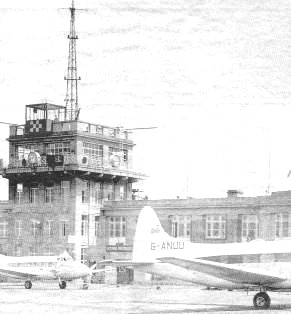
Addiscombe
Home
Heritage
Year 2006 Index
Feedback
The whitewash of an early fatal flight

A plane which crashed just after it left Waddon aerodrome in 1924, killing nine people, should have never been allowed to take off says a local history enthusiast.
The charred remains of eight passengers and the craft's pilot were all that was left of the midday flight to Paris after it plummeted into grassy banks in Croydon on Christmas Eve, 1924.
At that time the crash became the worst air disaster in aviation history, according to Brian Roote, who has been investigating the accident. The plane was a DH 34 aircraft and had taken off for Paris shortly after noon carrying five men, three women, the pilot and a large quantity of mail.
It seemed to struggle in strong winds and got into difficulty as it approached a 300 foot rise at Russell Hill, a mile from the aerodrome. It narrowly missed a house in Mount Park Avenue. and after trying to gain height the plane nose dived into the ground.
Brian from Whyteleafe said: "Immediately it struck the grassy slopes, the machine became a mass of flames as the petrol tanks burst and ignited. "None of the passengers stood any earthly chance of escape. Due also to the strong wind the flames became so fierce that any help was impossible and all on board were burnt to death in seconds."
"The repercussions from this tragedy were far reaching and the inquests and inquiries raised many questions, which in my opinion shows a degree of whitewashing."
Brian says significant information about the accident was unearthed by journalists at the time but were not included in any official inquiries.
He also questions the authenticity of aircraft safety certificates which were produced shortly after the accident. Newspapers reported the plane had only returned from Paris two hours before the crash and the pilot had reported problems with the engine and oil pressure.
Brian also claims the pilot had reported a similar problem on a previous trip. A public inquiry found there was no negligence, but Brian says: "As to the probable cause of the accident, several theories were put forward, but there is usually only one reason for a machine to nose-dive and that is stalling." In this case there are two possible reasons:
- One is that the engine failed shortly after take-off and the pilot tried to turn back.
- The second is that the machine was climbing slowly but got into a down current which forced it to lose height.
Both reasons are feasible but in view of the previously reported engine problems I am of the opinion that engine failure was the more likely cause.
Brian believes that two demonstrations at the aerodrome, five months after the accident, showing pilots "how to prevent aircraft, diving when stalled" are significant implications on what must have caused the crash and claims this supports his own theory.
Brian's detailed article on the crash will appear in a forthcoming edition of the Bourne Society's Local History Records. To subscribe call 01883 349 287.